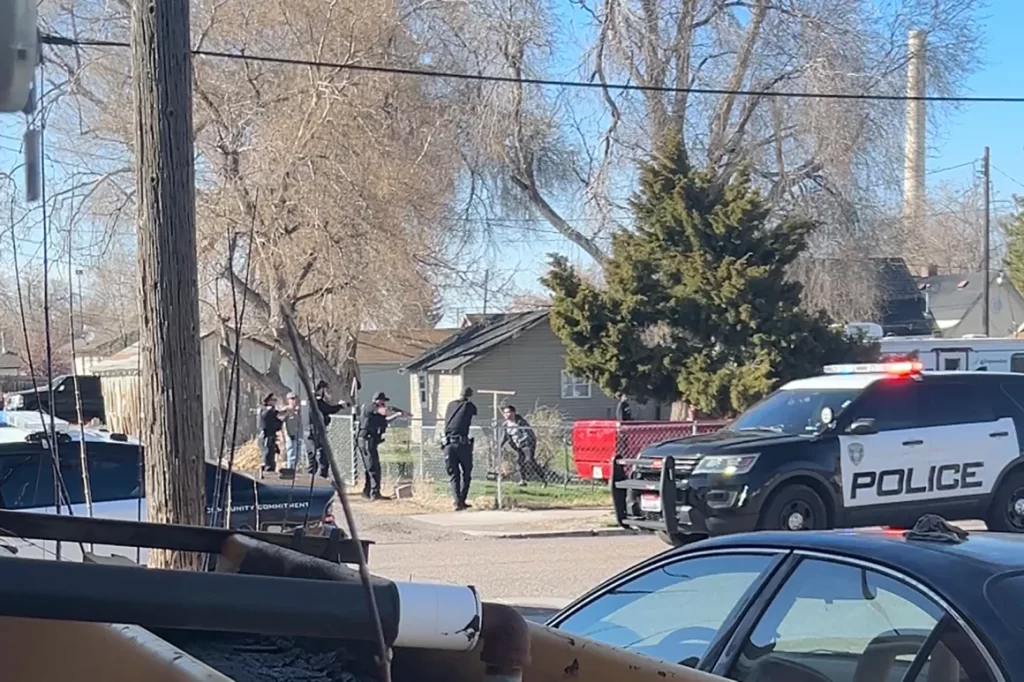Idaho police officers opened fire from behind a chain-link fence just seconds after exiting their patrol cars and critically wounded a teenage boy — described by his family as nonverbal, autistic and intellectually disabled — as he stepped toward them with a knife, video from a witness shows.
Seventeen-year-old Victor Perez, who also has cerebral palsy, remained hospitalized in critical condition Tuesday after having nine bullets removed from his body and having his leg amputated, Ana Vazquez, his aunt, told The Associated Press. Doctors were planning tests on his brain activity.
“We don’t know if he’s going to wake up,” she said.
The shooting Saturday in Pocatello outraged the boy’s family and neighbors as well as viewers online who questioned why the officers opened fire within about 12 seconds of exiting their patrol cars while making no apparent effort to de-escalate the situation or use less lethal weapons. Dozens of protesters gathered outside the police department Sunday, eastidahonews.com reported.
There is no indication the police were aware of the boy’s conditions.
“The police barely spoke to anyone,” Vazquez said. “They just said get back and they just, they shot to kill.”
In a video statement posted to the Pocatello Police Department’s Facebook page on Monday, Chief Roger Schei said he wanted to “provide clarity, share the information we can at this stage and address some misconceptions that have emerged.”
“We understand the concern and emotion surrounding the officer-involved shooting that occurred,” he said, adding, “We are also aware of the video circulating online, which shows only one angle. The full picture requires careful review of all facts and evidence.”
The events that led to the shooting
Brad Andres, who took the video, has an auto shop nearby and told the AP he noticed a disturbance when he stepped outside to take a phone call around 5:20 Saturday. His 19-year-old son, Bridger, called 911 and reported it as a domestic dispute in a backyard.
The 911 caller said an apparently intoxicated man — the teen — was wielding a kitchen knife and periodically chasing a man and woman in the yard, according to audio of the 911 call released by the Pocatello Police Department.
“He seems pretty drunk,” the caller told a dispatcher. “He’s just running at them with a knife and then falling over. I think he just stabbed himself, actually.”
The 911 caller noted that the people in the yard were not speaking English.
“He looks like he fell on the ground and kind of passed out,” the caller said.
In this image taken from video, police are seen shortly before opening fire on a teen on the other side of a fence Saturday in Pocatello, Idaho. Brad Andres/AP
Perez was still on the ground when police arrived at about 5:25 p.m. Four officers ran to the fence — three pulling out handguns and another pointing what appeared to be a shotgun. They ordered him to drop the knife. Instead, the boy stood up and began taking steps toward them with the knife in his hand. The officers shot repeatedly.
Andres said the police “appeared to be like a death squad or a firing squad,” adding: “They never once asked, ‘What is the situation, how can we help?’ They ran up with their guns drawn, they triggered a mentally disabled person to react and when he reacted … they shot him.”
“This was really traumatic for me to watch, for me and my son to be a part of,” Andres said. “My son was the one that called the 911 with the hopes of helping the family deal with the situation that was going on. He had no idea that what was going to transpire.”
Questions for the police
Schei said he would not answer questions about the shooting because of an investigation being conducted by the East Idaho Critical Incident Task Force.
“In situations like this, officers must make decisions in seconds,” Schei said. “They assess threats not just to themselves but to those nearby. In this case, two individuals were within a few feet of an armed, noncompliant individual. The risk was immediate, and the situation rapidly evolving.”
The Pocatello Police Department did not immediately respond to emails seeking further comment Tuesday, including questions about whether the officers were carrying Tasers or other less lethal options.
According to the department’s policy manual, all uniformed officers who have been trained to use Tasers must carry them, as well as either a baton or pepper spray.
Vazquez said Perez walked with a staggering gait because of his disabilities; he was not intoxicated. The boy’s 16-year-old sister yelled to the police not to shoot and that he was “special,” Vazquez said.
It was unclear if the police heard any such comments, which were not apparent on the video.
Seth Stoughton, a former police officer who teaches at the University of South Carolina Law School, said after watching the video that he had questions about why the officers did not use less lethal weapons or the basic tactic of backing up to create space between them and Perez.
“It does not appear to me that any officer is in immediate danger at the point where they begin shooting,” Stoughton said. “If he had made it over the fence and officers backed up and he continued to approach … then that could change.”
Vazquez said the family had never called police for help with the boy in the past and that this was his first interaction with law enforcement.
Across the country, police departments are increasing training for officers on best ways to identify and interact with people who may have developmental or intellectual disabilities, including many trainings centering on autism.
The trainings often focus in on ways people on the autism spectrum react to outside stimulus like noise or touching, that can be seen as resisting commands or resisting arrest to someone not on the spectrum.
Some groups have started providing stickers or marked license plates for people with autistic family members as a signal for police.
Pocatello is a city of just under 60,000 residents about 165 miles north of Salt Lake City.



